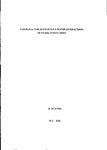COMPLEXATION AND PARTICLE-WATER INTERACTIONS OF NICKEL IN ESTUARIES
| dc.contributor.author | MARTINO, MANUELA | |
| dc.contributor.other | School of Geography, Earth and Environmental Sciences | en_US |
| dc.date.accessioned | 2013-09-24T11:22:29Z | |
| dc.date.available | 2013-09-24T11:22:29Z | |
| dc.date.issued | 2000 | |
| dc.identifier | NOT AVAILABLE | en_US |
| dc.identifier.uri | http://hdl.handle.net/10026.1/1927 | |
| dc.description.abstract |
The speciation and particle-water interactions of Ni were investigated in three estuaries with contrasting pollution levels, hydrodynamics and geochemical characteristics. Samples of water and sediments were collected seasonally from the Tamar, Tweed and Mersey Estuaries. The chemical speciation of dissolved Ni was determined by adsorptive cathodic stripping voltammetry (ACSV), and the sorptive behaviour of Ni was studied under simulated estuarine conditions using " Ni coupled to liquid scintillation counting. A relatively high particle reactivity was observed only in the Tamar Estuary, where ACSV-non labile Ni was removed in the low salinity region, followed by addition of ACSV-labile Ni in the mid-estuarine region. The largely conservative behaviour of dissolved Ni in the Tweed Estuary was attributed to the combination of rapid flushing and low suspended particles concentration. In the Mersey Estuary, dissolved Ni (and Co, Zn, Cd and Pb) often showed positive deviations from conservative behaviour, which were attributed to anthropogenic and/or geochemical inputs. The fraction of ACSV-non labile Ni behaved differently in the three estuaries, with a sharp decrease from 90 to 30% from freshwater to seawater in the Tamar, scatter between 30 and 70% in the Tweed, and relatively constant values of 50-70% in the Mersey. These differences are interpreted within the context of different hydrodynamics and geochemistry of the three estuaries. Speciation modelling showed that between 30 and 70% of dissolved Ni in the Tweed, and between 50 and 70% in the Mersey, was bound to a class of strong ligands (log K'NIL = 19.0 ± 0.4 and 18.7 ± 0.5, respectively), which were saturated by the ambient concentrations of Ni throughout the estuaries, suggesting that the ligands are highly specific towards Ni. Irradiation of riverwater samples with UV light (believed to remove dissolved organic matter) significantly enhanced Ni uptake onto estuarine suspended particulate matter, with an increase in the 63Ni distribution coefficients (Kds) of up to 10 fold. Conversely, the addition of synthetic humic acids to UV-treated riverwater decreased significantly the 63Ni Kds. Complexation of Ni by dissolved natural ligands also affected the progression of sorptive reactions, with a system response time (i.e. the time required to achieve 63% of the sorptive equilibrium) between 1.6 and 8.9 hours. The results from this study suggest that the low particle reactivity generally exhibited by Ni during estuarine mixing is due to its ability to complex strongly with dissolved natural ligands (truly dissolved organic or colloidal organic/inorganic), and therefore resist adsorption onto particles. | en_US |
| dc.language.iso | en | en_US |
| dc.publisher | University of Plymouth | en_US |
| dc.title | COMPLEXATION AND PARTICLE-WATER INTERACTIONS OF NICKEL IN ESTUARIES | en_US |
| dc.type | Thesis | |
| plymouth.version | Full version | en_US |
| dc.identifier.doi | http://dx.doi.org/10.24382/3802 | |
| dc.identifier.doi | http://dx.doi.org/10.24382/3802 |
Files in this item
This item appears in the following Collection(s)
-
01 Research Theses Main Collection
Research Theses Main


